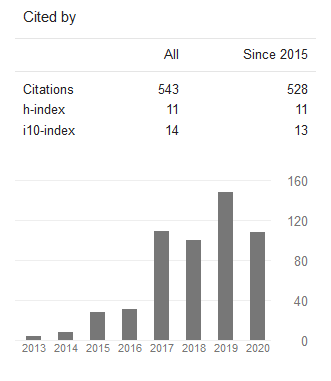Model Pengamanan End-to-End pada M-Banking Berbasis Algoritma Kurva Hyper Elliptic
DOI:
https://doi.org/10.24002/jbi.v7i4.765Abstract
Abstract. Currently, banking transactions using mobile banking has grown rapidly. The increasing the number of mobile application users becomes one of the main factors. Several approaches have been developed to improve the transaction security. Problems of message security still requires a solution to achieve computing speed and leverage security level. In this paper, we propose a security algorithms used to improve the mobile banking security with hyperelliptic curve algorithm. It will create a safe and an efficient transactions while message will be sent via public internet. Hyperelliptic curve algorithm will run a processes for authentication and encryption. it will produce fast computation and has good security level. This research produced little computing time on m-banking application while it run on Android. Hyperelliptic curve algorithm use a smaller key to achieve a good security level at m-banking application.
Keywords: hyperelliptic curve algorithm, security, mobile banking.
Abstrak. Saat ini, transaksi perbankan baik di dalam dan di luar menggunakan Mobile Banking semakin pesat, meningkatnya jumlah pengguna aplikasi mobile menjadi salah satu faktor utamanya. Beberapa pendekatan telah dikembangkan untuk meningkatkan keamanan transaksi pesan selama komunikasi. Masalah yang masih memerlukan solusi adalah kecepatan komputasi dan tingkat keamanan pada algoritma pengamanan yang digunakan. Penelitian ini dilakukan untuk meningkatkan keamanan pesan mobile banking dengan memanfaatkan algoritma kurva hyper elliptic. Hal ini dilakukan untuk mewujudkan transaksi yang aman dan efisien dengan penerapan metode kriptografi pada pesan. Dengan menggunakan algoritma kurva hyper elliptic maka proses autentikasi dan enkripsi pesan bisa dilakukan dengan cepat dan memiliki level keamanan yang tinggi. Penelitian ini menghasilkan waktu komputasi yang cukup cepat pada aplikasi m-banking berbasis Android. Hal ini karena, algoritma kurva hyper elliptic menggunakan panjang kunci yang lebih kecil untuk mencapai level keamanan yang baik pada aplikasi m-banking.
Kata Kunci: algoritma kurva hyper elliptic, keamanan, mobile banking.
References
Bartolini, S., Branovic, I., Giorgi, R., & Martinelli, E. (2008). Effects of Instruction-Set Extensions on an Embedded Processor: A Case Study on Elliptic Curve Cryptography over GF (2 m). Computers, IEEE Transactions on,57(5), 672-685.
Budiono. (2013). “Penerapan Tanda Tangan Digital Untuk Keamanan Transaksi Sms – Banking,” ITB Bandung.
Faruki, P., Bharmal, A., Laxmi, V., Ganmoor, V., Gaur, M. S., Conti, M., & Rajarajan, M. (2015). Android security: a survey of issues, malware penetration, and defenses. Communications Surveys & Tutorials, IEEE, 17(2), pp. 998-1022.
Ganesan, R, & Vivekanandan, K, (2011). Comparative Analysis Of Higher Genus Hyperelliptic Curve Cryptosystems Over Finite Field FP, ICTACT Journal On Communication Technology. 2(1). pp. 238-240.
Ham, L. (2013). “Group Authentication”. IEEE Trans. Vehicular Technology, 62(9).
Ku, W. C. (2005). Weaknesses and drawbacks of a password authentication scheme using neural networks for multiserver architecture. IEEE transactions on neural networks/a publication of the IEEE Neural Networks Council, 16(4), 1002-1005.
Kumar, N., Mathur, A., & Lal, S. (2013). Banking 101: Mobile‐izing Financial Inclusion in an Emerging India. Bell Labs Technical Journal, 17(4), 37-41.
Lauter, K. (2004). The advantages of elliptic curve cryptography for wireless security. IEEE Wireless communications, 11(1), 62-67.
Li, D., Lin, D., Zhao, G., & Huang, B. (2009). Design and correctness proof of a security protocol for mobile banking. Bell Labs Technical Journal, 14(1), 259-265.
Menezes, A., Wu, Y. & Zuccherato, R. (1996). An elementary introduction tohyperelliptic curves. Department of C&O, University of Waterloo, Ontario, Canada.
Ren, K., Yu, S., Lou, W., & Zhang, Y. (2009). Multi-user broadcast authentication in wireless sensor networks. Vehicular Technology, IEEE Transactions on, 58(8), 4554-4564.
Rifà-Pous, H., & Herrera-Joancomarti, J. (2011). Computational and Energy Costs of Cryptographic Algorithms on Handheld Devices, Future Internet, 3 (1): 31-48.
Rivest, R.L., Shamir, A., Adleman, L. (1994). “AMethod for Obtaining DigitalSignatures and Public-KeyCryptosystems”, Massachusetts Institute of Technology, Cambridge.
Shih, K. H., & Lin, C. Y. (2015). Is mobile banking a competitive weapon?. International Journal of Electronic Finance, 8(2-4), pp. 189-201.
Singh, B., & Jasmine, K. S. (2015). Secure End-To-End Authentication for Mobile Banking. In Software Engineering in Intelligent Systems (pp. 223-232). Springer International Publishing.
Smart, N. P. (1999). On the performance of hyperelliptic cryptosystems. In Advances in Cryptology—EUROCRYPT’99 (pp. 165-175). Springer Berlin Heidelberg.
To, W. M., & Lai, L. S. (2014). Mobile banking and payment in China. IT Professional, 16(3), 22-27.
Vasco. (2009). Security: a major concern for the adoption of m-banking. (Online, http://www.banking-businessreview.com/suppliers/vasco_strong_authentication_and_e_signature_specialising_in_online_accounts_identities_and_transactions/whitepapers/security_a_major_concern_for_the_adoption_of_m_banking)
Vijayakumar, P., Vijayalakshmi, V., & Zayaraz, G. (2014). Comparative Study of Hyperelliptic Curve Cryptosystem over Prime Field and Its Survey. International Journal of Hybrid Information Technology, 7(1), 137-146.
Downloads
Published
Issue
Section
License
Copyright of this journal is assigned to Jurnal Buana Informatika as the journal publisher by the knowledge of author, whilst the moral right of the publication belongs to author. Every printed and electronic publications are open access for educational purposes, research, and library. The editorial board is not responsible for copyright violation to the other than them aims mentioned before. The reproduction of any part of this journal (printed or online) will be allowed only with a written permission from Jurnal Buana Informatika.
This work is licensed under a Creative Commons Attribution-ShareAlike 4.0 International License.









